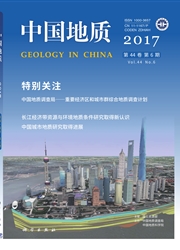

 中文摘要:
中文摘要:
中亚造山带是古亚洲洋演化与最终消亡的产物。北山地区处于该造山带中段南部,是中国重要的铜、钼、金、铁多金属成矿带。北山地区在晚古生代-早中生代曾发生过2次碰撞造山作用,一次发生于晚古生代末,与古亚洲洋的最终闭合有关;另一次发生于早中生代三叠纪,与北山南带发育的石炭纪-二叠纪裂谷封闭有关。因此,从时间演化看,中生代三叠纪北山地区为碰撞-碰撞后造山阶段,发育大规模剪切带和强烈的岩浆活动及伴生的金属成矿作用。北山地区中生代岩浆活动以深成侵入相发育并缺失相应的喷出相为特征;岩石类型以中酸性侵入岩为主,基性侵入岩局部可见,S、I、A型花岗岩均有产出。与中生代岩浆活动有关的矿床类型主要包括与I-A型花岗岩伴生的斑岩钼矿床、与S型花岗岩伴生的钨(锡)矿床、与中酸性侵入体有关的矽卡岩型金、银铜铅锌多金属矿床和与中酸性侵入体有关并受剪切带控制的金矿床。中生代印支期是该地区最晚一次大规模岩浆活动与金属成矿时期,其发育的范围、规模和强度均比原来认识的要广泛的多,值得进一步关注。
 英文摘要:
英文摘要:
The Central Asian Orogenic Belts (CAOB) resulted from evolution and final closure of the Plaeo-Asian Ocean(s). Located in the central segment of the southern portion of the CAOB, the Beishan area, which refers to the conjunction region of Inner Mongolia, Gansu and Xinjiang, is one of the most important metallogenic belts in China, with abundant Cu, Mo, Au, Fe and base metal deposits. Two collisional events took place in the Beishan area during Late Paleozoic-Early Mesozoic:one occurred at the end of Late Paleozoic, which was related to the final closure of the CAOB, and the other took place in Early Mesozoic, resulting from the closure of the Carboniferous-Permian rifts in southern Beishan. As a consequence, the Beishan area was involved, in terms of temporal relations, in a collision to post-collision stage in Indosinian epoch of Mesozoic period, during which large-scale ductile shear zones and intensive magmatism as well as associated metallic mineralization occurred. The Mesozoic magmatism, which is predominated by intermediate-felsic intrusions locally with minor basic ones, is characterized by plutonic intrusive facies, without extrusive counterpart. Petrogenically, S-, I-and A-type granites have been delineated in the area. Types of Mesozoic mineral deposits in the area mainly include porphyry-type Mo mineralization, which is associated with I-and/or A-type granites, W (Sn) deposits associated with S-type granites, skarn-type Au-Ag-Cu polymetallic deposits associated with intermediate-felsic intrusions, and Au deposits related to granitic intrusions and controlled by ductile shear zones. Indosinian epoch is the latest period of major magmatism and metallic mineralization in the area, to which more attentions should be paid since the Indosinian granitoid intrusions and associated mineral deposits may be much more extensive and abundant than recognized presently.
 同期刊论文项目
同期刊论文项目
 同项目期刊论文
同项目期刊论文
 期刊信息
期刊信息
